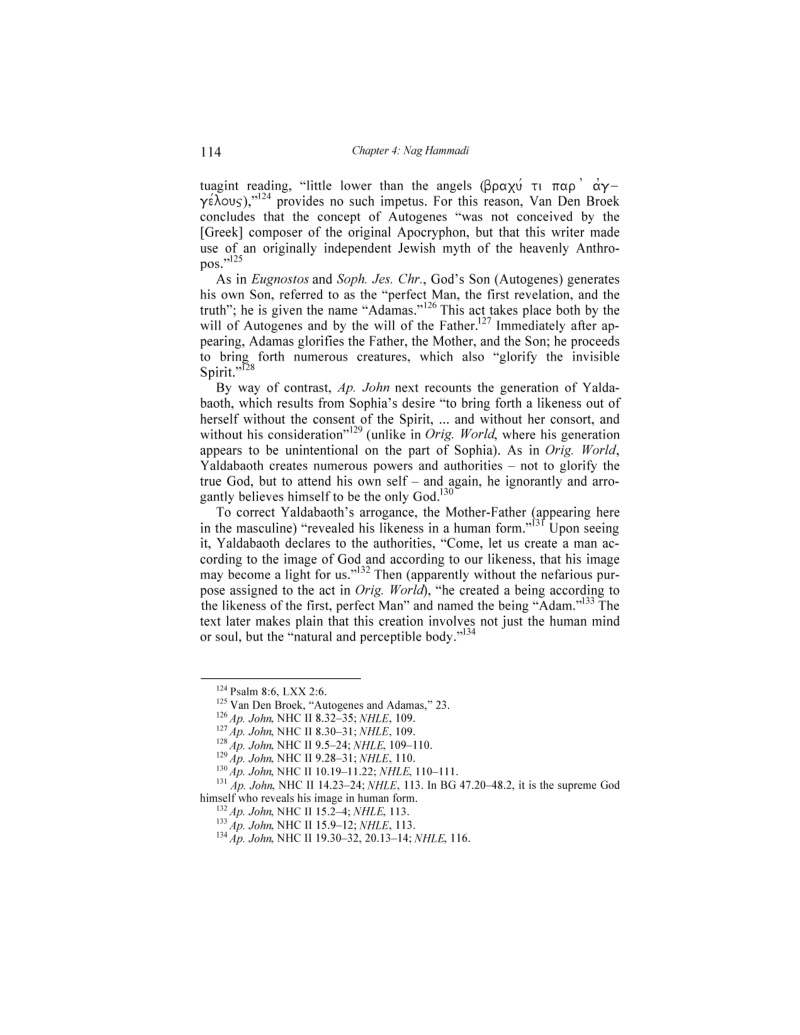Paul A. Patterson discusses "Adamas" in the Apocalypse of John: he is the son of Jesus, described as the "first perfect man" and is related in a special way to Adam.
- Type
- Book
- Source
- Paul A. Patterson Non-LDS
- Hearsay
- Secondary
- Reference
Paul A. Patterson, Visions of Christ: The Anthropomorphite Controversy of 399 CE (Studien und Texte zu Antike und Christentum 68; Tübingen: Morh Siebeck, 2012), 114-15
- Scribe/Publisher
- Mohr Siebeck
- People
- Paul A. Patterson
- Audience
- Reading Public
- Transcription
As in Eugnostos and Soph. Jes. Chr., God’s Son (Autogenes) generates his own Son, referred to as the “perfect Man, the first revelation, and the truth”; he is given the name “Adamas.” This act takes place both by the will of Autogenes and by the will of the Father. Immediately after appearing, Adamas glorifies the Father, the Mother, and the Son; he proceeds to bring forth numerous creatures, which also “glorify the invisible Spirit.”
By way of contrast, Ap. John next recounts the generation of Yaldabaoth, which results from Sophia’s desire “to bring forth a likeness out of herself without the consent of the Spirit, ... and without her consort, and without his consideration” (unlike in Orig. World, where his generation appears to be unintentional on the part of Sophia). As in Orig. World, Yaldabaoth creates numerous powers and authorities – not to glorify the true God, but to attend his own self – and again, he ignorantly and arrogantly believes himself to be the only God.
To correct Yaldabaoth’s arrogance, the Mother-Father (appearing here in the masculine) “revealed his likeness in a human form.” Upon seeing it, Yaldabaoth declares to the authorities, “Come, let us create a man according to the image of God and according to our likeness, that his image may become a light for us.” Then (apparently without the nefarious purpose assigned to the act in Orig. World), “he created a being according to the likeness of the first, perfect Man” and named the being “Adam.” The text later makes plain that this creation involves not just the human mind or soul, but the “natural and perceptible body.”
The “first, perfect Man” who appears here in human form and who functions as the archetype of humanity is likely Adamas (and not Autogenes/Christ): first, the phrases “perfect Man” and “first revelation” have already been used in Ap. John to describe Adamas; second, the name Adamas indicates that this being is related in a unique way to Adam. No doubt this is a development of the tradition as it appears in Orig. World, in which the highest manifestation of God (Immortal Man/Christ) fulfils these roles. Such a development would have been intended to place even more distance between God and the corporeal world. Of course, no such distance is needed for one who thinks of God as creator. Hence (as discussed in Chapter 5) Philo’s Logos can function as the highest manifestation of God and as the archetype of humanity. Of course, the anthropomorphites would assign both of these functions to Christ.
- Citations in Mormonr Qnas
The B. H. Roberts Foundation is not owned by, operated by, or affiliated with the Church of Jesus Christ of Latter-day Saints.

